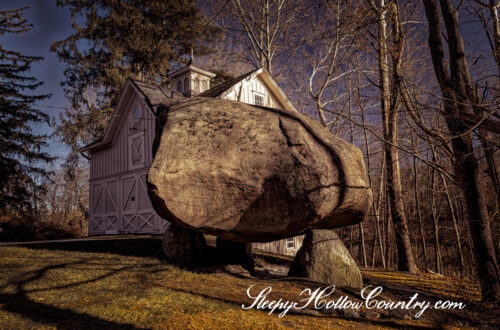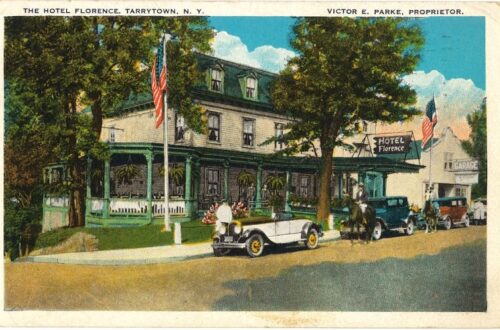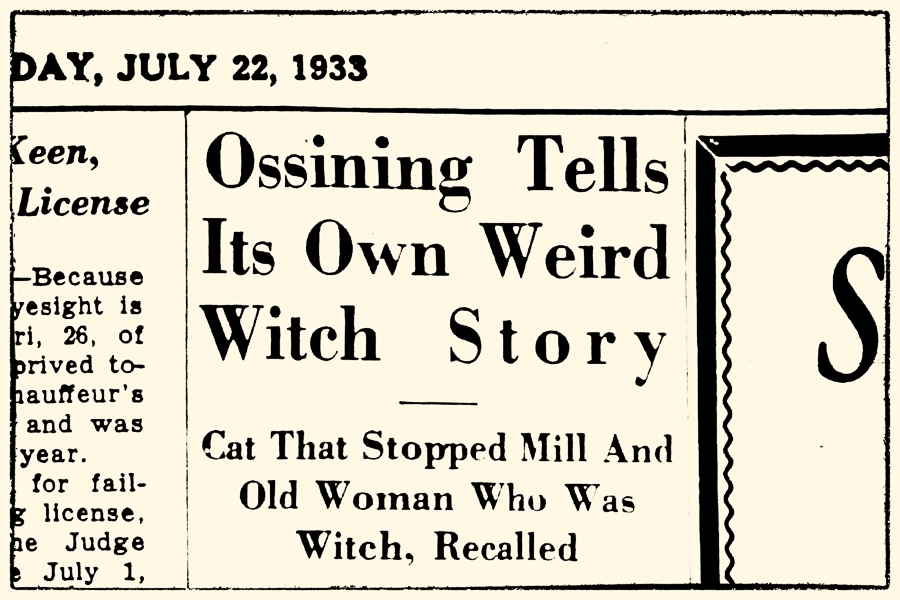
The Bewitched Mill of Sing Sing
The tale of the bewitched mill of Sing Sing, or the Ossining witch, comes to us down a winding path that begins at the ancient and now vanished shad fishing camp at Crawbucky Point, where local legends were told and retold around the evening campfires.
But before we dive into our story of the bewitched mill, let’s take a brief detour into the shifting name of the village presently known as Ossining. 17th Century Dutch maps of the Hudson River show a settlement on the east shore occupied by a band of the Mohegan tribe known as “Sint Sinck.” In 1813 European settlers founded a village they called Sing Sing, Anglicizing the native name.
A decade later, New York State began construction of a prison in the village, which was also named Sing Sing. As the prison gained notoriety, the village tried to distance itself and changed its name to Ossining on March 25, 1901. In our tale, Sing Sing refers to the village, not the prison.
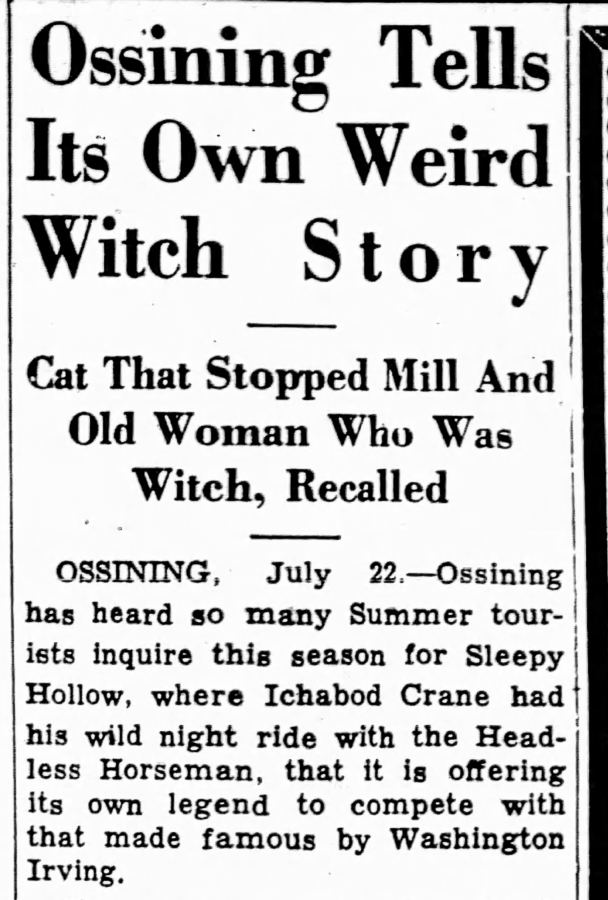
Now back to the story of the Ossining witch. Here at Sleepy Hollow Country we first got wind of this legend when we happened upon a July 22, 1933 newspaper article in The Daily Item of Port Chester, New York. Under the headline “Ossining Tells Its Own Weird Witch Story”, the unnamed reporter described a village mildly annoyed at being upstaged by a rival village known for a Headless Horseman: “Ossining has heard so many Summer tourists inquire this season for Sleepy Hollow, where Ichabod Crane had his wild night ride with the Headless Horseman, that it is offering its own legend to compete with that made famous by Washington Irving.”
The article recounts the tale of an old mill formerly located in “what is now a thriving business section” that had a rash of mechanical issues, all occurring at the stroke of midnight. The miller, convinced that something more than just a bad gear was at play, decided to take matters into his own hands.
As the clock struck twelve, in ran the culprit: a cat. Not just any cat, but a cat with the audacity to casually stroll through the grain hopper like it owned the place. The miller, in a mix of terror and annoyance, shot at the feline. The cat escaped, but not before leaving behind a bit of evidence—a trail of blood from an injured paw.
For many days after, a “certain ancient dame” in the nearby hamlet of Sparta went around with one arm in a sling and avoided staying out after dark, apparently guarding herself against her neighbors who had long suspected her of being a witch.
Was there an Ossining Mill?
Naturally, this tidbit got us hungry for more information about an alleged Ossining witch with a penchant for tampering with the machinery of an old mill. We started our inquiry by looking for evidence of an historic grain mill in downtown Ossining. Many tributaries of the Hudson River were dammed to provide water power for mills of various types of manufacturing, including Sing Sing Kill that runs through the downtown area. Had there been a grain mill in Ossining? Without a mill the story wouldn’t hold up.
We turned first to the collection of Sanborn fire insurance maps at the Library of Congress. Sure enough, the 1886 Sanborn series documents the M. Cypher feed mill on the “Kill Brook” just below Brandreth Street. It would have been located a little below today’s Full Gospel Tabernacle Church, but no remnants of the structure survive today. A note on the word ‘kill’: this is the North American colonial Dutch word for creek or river, making the Anglicized “Kill Brook” redundant.
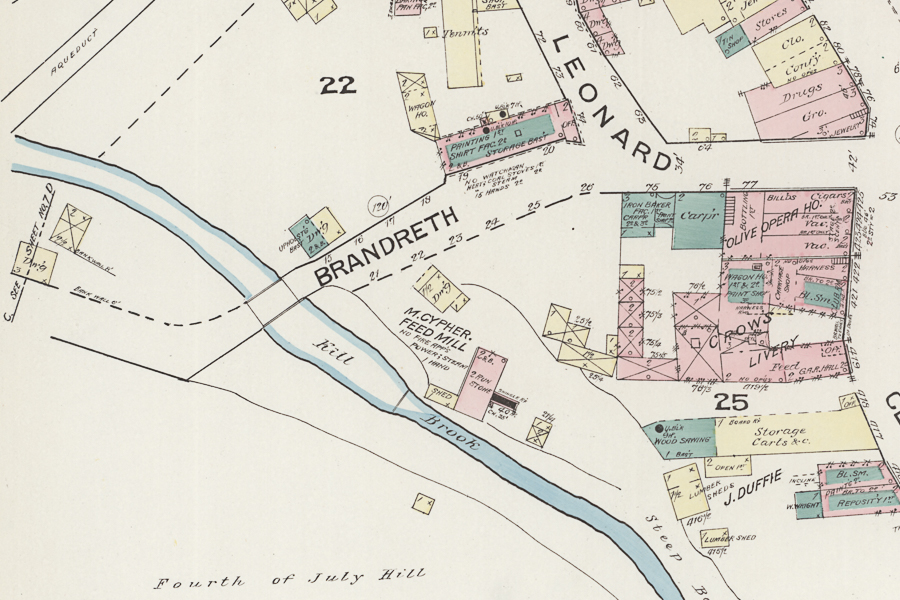
Searching the Archives for an Ossining Witch
With the presence of a mill established we next sought out additional newspaper reports on the Ossining witch story. Finding none in our usual sources, we turned to the archives of the Westchester County Historical Society where we uncovered a battered copy of a 1922 pamphlet titled Reminiscences of Ossining. This brief collection of history and legends was compiled by Florence Leary Reynolds, historian of the Mohegan Chapter of Daughters of the American Revolution. It was published by The Moran-Register Press of Ossining, NY.
In it appeared a vignette titled “The Legend of the Bewitched Mill” in which a group of fishermen at the shad camp on Crawbucky Point, waiting for a favorable tide to check their nets, swap stories after dinner. One fisherman remarked that his pocket watch must be bewitched as it had a habit of regularly stopping a certain hour of the day. That elicited a response from an old timer that the watch’s punctuality bore a resemblance to an old mill on the Sing Sing Kill that was known to break down every night at midnight.
After the break is the original text of “The Legend of The Bewitched Mill”.
On one of these long ago visits of the Sing Sing boys on the beach after the combined feast of visitors and hosts had been duly discussed and found good, the casual remark of one of the company that his watch must be bewitched (it had got in the habit of stopping at a certain hour), brought forth response from one of the old fishermen that the watch must be “like the old mill up in Kil Brook my father used to tell about, which once upon a time got to stopping every night at twelve o’clock.”
Of course, everyone present wanted to know what happened to the mill, and the tide not yet being right to begin work of drawing the seine, “everyone present” was accommodated with story here told, not in the picturesque words of the old fisherman, but as best memory can recall the principal features of
The Legend of The Bewitched Mill
Years and years ago, before the railroad with its embankments and depots, its shrieking locomotives and rumbling cars, brought Sing Sing within an hour’s ride of the metropolis and drove every bit of romance from the east shore of the Tappan Zee; before gas was known or telegraphy thought of, Sing Sing was a market town of some importance to the farmers the country ’round, and the grist mill, situated on the Kil, a little below the present site of the gas house, had a very high reputation for the good quality of its work, and was, consequently well patronized by all who had grain to be ground.
At certain seasons of the year there was so much to do that it was necessary in order to do all that was required, to run the mill night and day. It was during one of these busy seasons that a series of singular coincidences occurred: At midnight, just on the last stroke of twelve, the mill would stop, and vain were all efforts to induce it to go until morning. As might be supposed, every part of the machinery was overhauled, oiled and repaired; but all to no purpose. At twelve o’clock every night, stop the mill would, and nothing but daybreak would set it going again.
The miller was sore perplexed at this unwonted behavior on the part of the mill, and, after long pondering during which its nightly stoppings continued, concluded that the mill was bewitched, and that the hopper thereof was the particular portion affected.
Accordingly, the miller resolved to watch the hopper at night and note occurrences carefully. The night he had chosen was dark and stormy but armed with lighted lantern, a Bible and a shotgun, he determinedly took his position and awaited developments.
Slowly the hours went by; nothing to be heard but the monotonous clang of the mill, howls and shrieks of the storm and rustlings of rats and mice. Lonesome enough was the miller, you may be sure; and as the mvstic hour of midnight approached, with equal reliance did grasp both Bible and gun. Imagine his surprise when, on the first stroke of twelve from the old dock in the mill office, he beheld an immense black cat, with an unearthly howl, bound through a broken window and run around the hopper. The mill immediately stopped, and the cat, completing the circuit, with another howl made for the window. Before she reached it the miller had recovered from his surprise sufficiently to take hasty aim with his gun the fire at the retreating animal, and with some effect; for though the animal escaped, yet bloody proofs were found on the sill that one of its paws had been broken by the shot.
As a sequel it was stated that the mill ever after did its work without any more mysterious and periodic stoppings, and that a certain ancient dame, who lived down towards Sparta, long suspected of being a witch, for a long time after, and commencing with the very morning after the shooting of the cat by the miller in the old mill, wore her arm in a sling with her hand bandaged.
Know of a bewitched building we’ve missed? Our millstones are always ready to grind out another tale. Ghost.editor@sleepyhollowcountry.com.



